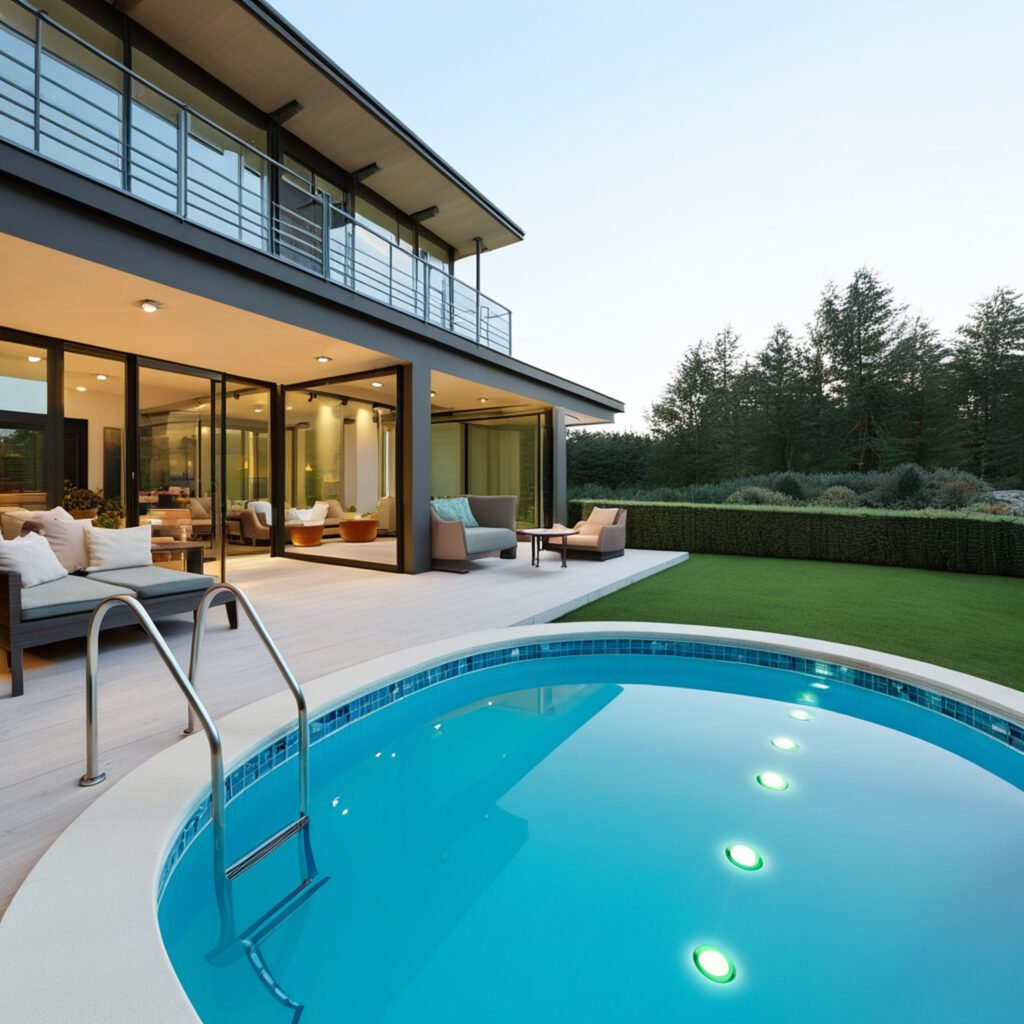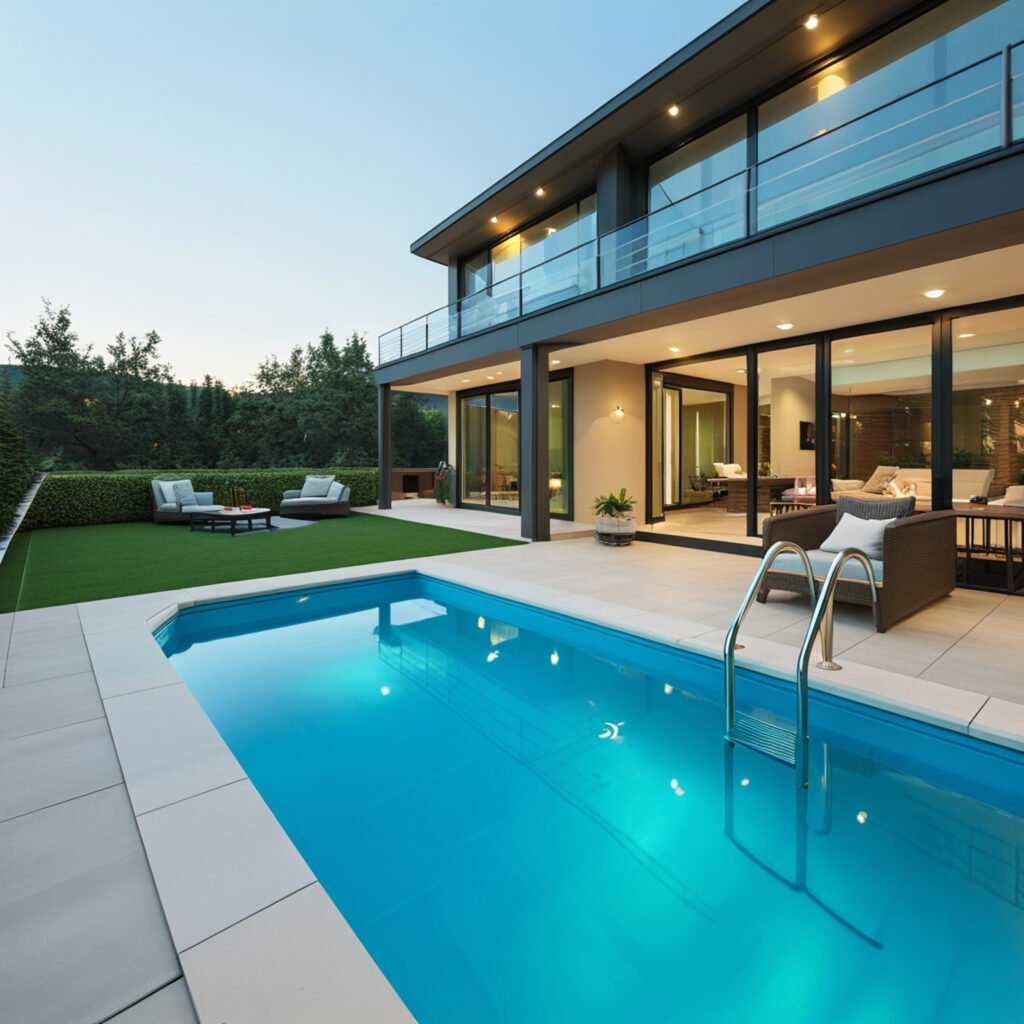Swimming pool trends are transforming homeowners’ approach to backyard swimming. Home prices with pools now command a premium of approximately 54%, returning to pre-pandemic levels. The market shows a most important move as swimming pools evolve from luxury items into essential lifestyle features.
Pool features in home listings have hit a record 24.4% in April 2025. A well-laid-out inground swimming pool adds 5-8% to a property’s value. On top of that, properties with pools in warmer climates like Los Angeles sell for about $95,000 more than those without them. This piece explores why pool trends change faster and what smart homeowners prioritize to maximize their investment.
Why homeowners are rethinking pools in 2025
People all over the country are taking a fresh look at their swimming pools. They’re turning these water features from basic recreation spots into versatile extensions of their living spaces. New pool trends show how our view of homes and outdoor spaces is changing.
The post-pandemic move to outdoor living
Our outdoor spaces became incredibly important as places to relax, work, eat, and play during lockdowns. Many homeowners wanted to boost their backyards and make them useful all year round. The International Casual Furnishings Association reports that over 80% of Americans wanted more attractive, comfortable, and practical outdoor spaces after the pandemic. Swimming pools changed from summer luxuries to vital parts of daily life during this time.
From luxury to lifestyle necessity
The swimming pool market has looked completely different over the last several years. These pools have grown from an exclusive feature in wealthy neighborhoods into a well-thought-out part of modern living. These water features now serve as detailed wellness centers that run year-round, not just in summer months.
Modern pools play a key role in health routines. Homeowners now add lap pools for fitness, spa features for relaxation, and cold plunge areas for athletic recovery and reducing inflammation. The smooth integration of smart technology lets owners control lighting, heating, and filtration systems remotely, which cuts down maintenance work by a lot.
How buyer expectations have evolved
Pool buyers today care about both function and beauty. After looking at costs, homeowners ranked looks (71%), durability (71%), and comfort (69%) as their top priorities when buying products. The “pool premium” has dropped from its January 2022 peak of 61% to about 54% in 2025, but demand stays strong.
Modern buyers expect more value from their pool investment. They’re turning backyards into detailed entertainment zones with pool houses, cabanas, sitting areas, and outdoor kitchens. The focus has moved toward creating smooth indoor-outdoor flow with features like glass walls and open layouts that make pools feel like natural home extensions.
The changing value of swimming pools in homes

Swimming pools mean something different to homeowners now compared to pre-pandemic times. Anyone looking to add a pool needs to weigh both the investment value and lifestyle benefits. The numbers tell an interesting story about what these backyard oases really mean for property values.
Price premiums: Then vs. now
Pool values have seen quite a ride these past few years. Homes with pools saw an amazing 61% price premium during peak pandemic demand in January 2022. The premium sits at about 54% as of April 2025, which shows the market finding its balance rather than losing value.
The real numbers paint a clear picture. A typical pool home in 2025 lists at $599,000 while similar homes without pools go for $389,000. This is a big deal as it means that prices have jumped since 2019, when pool homes averaged $415,000 and non-pool properties sold for $274,000.
Your location plays a huge role in what a pool adds to your home’s value. A well-designed pool in Los Angeles might boost your home’s value by nearly $100,000, but that same feature in Phoenix might only add $11,591.
Size and square footage considerations
Here’s something that affects these numbers – pool homes are usually bigger. Pool properties in April 2025 averaged 2,450 square feet, while homes without pools came in at 1,850 square feet – about 32.4% or 600 square feet more space.
This size gap hit its highest point in January 2021, with pool homes being 38% larger than those without. Back in 2019 and 2020, the difference was even more striking at over 700 square feet.
Money talks when it comes to pools. Expensive homes are more likely to have pools, which makes sense given their larger lots and what buyers expect at higher price points.
Price per square foot: A clearer picture
The “pool premium” becomes easier to understand through price-per-square-foot analysis. April 2025 data shows pool homes commanding $247 per square foot, while non-pool properties averaged $204 – a 21.2% premium.
This premium has cooled slightly from its pandemic peak of 25.6% ($45 difference) in February 2022. Price per square foot gives us a better idea of what the pool itself adds to the home’s value, separate from the size factor.
Where you live really matters. Warm climate homes with year-round pool use see stronger value gains. Cold climate properties might see little value added or even lose value once you factor in maintenance costs.
Design trends shaping inground swimming pool choices
Modern inground swimming pool designs show a fundamental change toward sophisticated features that combine beauty with practicality. Pool owners now want spaces that can do multiple things and match their home’s style.
Geometric shapes and minimalist aesthetics
Clean lines and symmetrical designs lead today’s pool trends. Rectangular and L-shaped pools have become more popular because they create architectural balance that works well with modern homes. These geometric pools work great for lap swimming and create an elegant, clean look. Dark blue finishes now replace neutral tones, and homeowners prefer continuous patterns instead of tile borders.
Tanning ledges and integrated spas
Tanning ledges have become must-have features in high-end pools. These shallow areas, usually 6-12 inches deep, are also known as sun shelves or Baja shelves. They make great play areas for kids, relaxation spots for adults, and easy entry points for people with limited mobility. Built-in spas with spillover features have also become very popular because they offer two functions in one.
Eco-conscious materials and energy efficiency
Green-minded homeowners now focus on eco-friendly pool options. Variable-speed pumps help cut energy costs by up to 55%, and solar heating systems reduce environmental harm. Green construction materials that you can recycle, last longer, and help the environment have become key factors in pool design.
Smart pool technology and automation
Pool ownership has changed thanks to automation. New systems let you control lights, heat, filters, and water features from your phone. Cloud-based smart monitors help you manage pool chemistry and temperature from anywhere. This makes maintenance easier and saves energy costs.
What smart homeowners are prioritizing in 2025

Smart property owners in 2025 know that pool investments can do much more than just look good. They understand how pools add value to their lifestyle and property.
Multi-functional outdoor spaces
Homeowners now blend their pools into complete outdoor living spaces. These areas feature outdoor kitchens with built-in grills, refrigerators, and sinks that create smooth entertainment zones. Weather-resistant fabrics and smart shade solutions make seating areas more functional. The best designs now see pools as part of a unified outdoor living space.
Compact and plunge pools for smaller lots
New construction homes come with smaller lots, making compact pools a popular choice. Plunge pools that measure under 10 feet long need minimal space but offer great benefits:
- You’ll spend less on maintenance and get faster installation
- They work well for water exercises and relaxation
- Your heating costs drop by 50-70%
Safety and accessibility for all ages
Modern pool designs must be accessible to everyone. Zero-entry (beach-entry) pools with gradual slopes help people with mobility challenges. On top of that, non-slip surfaces, handrails, and proper lighting boost safety by a lot. Pool lifts can make existing pools accessible without major renovations.
Strategic upgrades for long-term ROI
Homeowners focus on improvements that pay off well, especially when you have:
- Smart technology with mobile app controls and automated monitoring (giving back 50-65% of investment costs)
- Salt water conversion systems that cut down chemical handling and maintenance costs
- Quality deck renovations that can return 100-120% of costs in markets that value outdoor spaces
Conclusion
Swimming pools have evolved from luxury items to lifestyle features that add substantial value to modern homes. The housing market in 2025 shows pools now fetch a 54% price premium, which shows how much they matter in today’s living spaces.
Numbers tell us that good pool designs boost property values by 5-8% across the country, with warm regions seeing even better returns. Location makes all the difference, though. A Los Angeles homeowner might see nearly $100,000 in added value, while someone in Phoenix might gain just over $11,000 for the same pool.
Modern homeowners just need their pools to work harder for their money. Clean geometric designs, tanning ledges, integrated spas, and smart automation systems are now standard features. The market has adapted to smaller lot sizes with compact and plunge pools that don’t sacrifice functionality.
Pools these days are more than just standalone features. They’ve become the heart of complete outdoor living spaces that include kitchens, cozy seating areas, and entertainment zones. This integrated approach changes backyards into natural extensions of indoor spaces.
Green-minded homeowners benefit from new tech like variable-speed pumps and solar heating systems that cut both environmental impact and running costs. Zero-entry designs and non-slip surfaces make pools enjoyable for family members of every age and ability.
Smart homeowners will keep making pool investments that balance good looks with practical use. People who think over their local climate, available space, and lifestyle needs will find pools worth the investment, both money-wise and for better living. These days, a pool’s true value goes way beyond the reach of simple water features to create outdoor sanctuaries that boost our daily lives.
